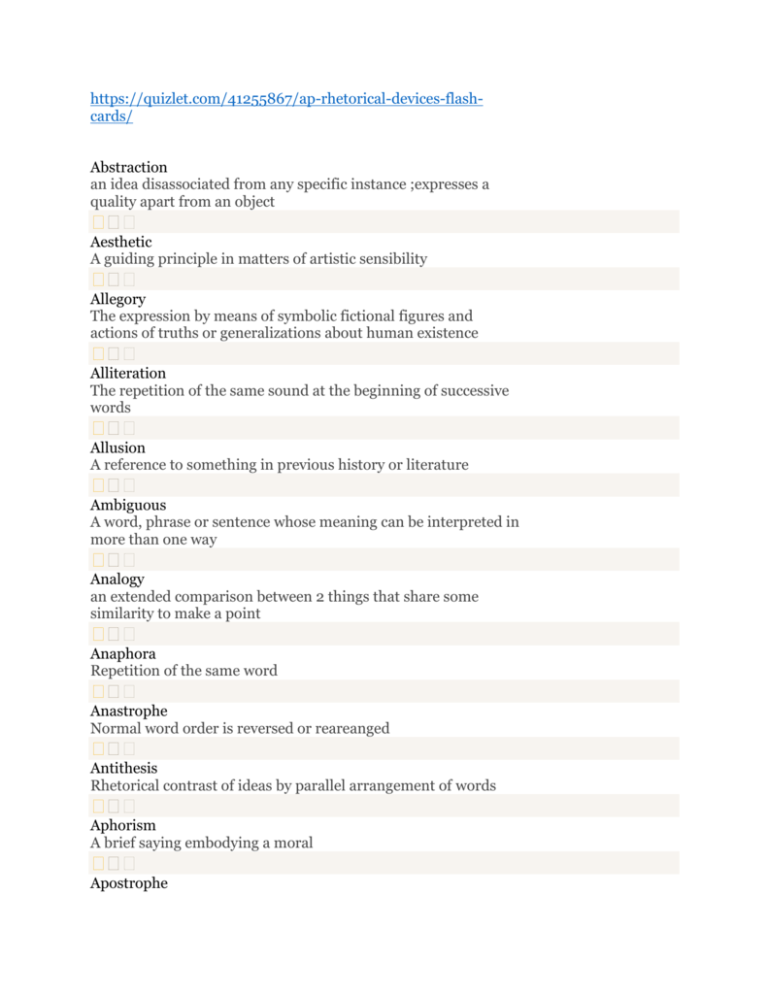AP Rhetorical Devices Flashcards
advertisement

https://quizlet.com/41255867/ap-rhetorical-devices-flashcards/ Abstraction an idea disassociated from any specific instance ;expresses a quality apart from an object Aesthetic A guiding principle in matters of artistic sensibility Allegory The expression by means of symbolic fictional figures and actions of truths or generalizations about human existence Alliteration The repetition of the same sound at the beginning of successive words Allusion A reference to something in previous history or literature Ambiguous A word, phrase or sentence whose meaning can be interpreted in more than one way Analogy an extended comparison between 2 things that share some similarity to make a point Anaphora Repetition of the same word Anastrophe Normal word order is reversed or reareanged Antithesis Rhetorical contrast of ideas by parallel arrangement of words Aphorism A brief saying embodying a moral Apostrophe When an absent person or an abstract concept is directly adressed Appositive A noun that renames another noun beside it Assonance Repetition of vowel sounds NOT consonants Asyndeton Conjunctions are omitted producing a rapid prose Atmosphere Mood insinuated by literary Audience The person to whom comments are directed Bildungsroman Story of an individuals growth Cacophony Harsh, discordant words. Opposite of euphony Chiasmus Repetition of ideas in an inverted order Climax Ideas arranged in order of importance Colloquialism Characteristic of spoken or written communication that imitates informal speech Concrete Identifies things perceived through the senses Connotation Set of associations implied by a word in addition to literal meaning OR repetition of consonant words Denotation Dictionary meaning of a word Detail Creating a simple image without connotation Dialect A regional variety of language distinguished by features of vocab grammar and and pronunciation Diction Writers choice of words to combine meaning Didactic Tone designed to teach an ethical moral or religious lesson Dramatic monologue A speaker addresses a distinct but silent audience imagined to be present to reveal a dramatic situation Elegiac Tone involving mourning for something that had passed Ellipsis Omission of 1 or more words that are understood but that must be supplied to make a construction grammatically complete Epigraph Quotation set at the beginning of a literary work; may suggest its theme Epistrophe Ending a series of sentences with the same word. Opposite of anaphora Euphemism Substitution of an agreeable or inoffensive expression for one that may be offensive Euphony Soothing pleasant sounds Extended metaphor Several comparisons similar in theme Figures of speech Creates special effects or feelings Generalization Idea that emphasizes generality, not detail Genre Category based on style, form & content Hyperbole Exaggeration done for emphasis Idiolect A persons own language Idiomatic Mode of expression peculiar to a language Imagery Appeals to more of the 5 senses Inflection Change of form words undergo to mark distinctions (gender,number,tense..) Invective Relating to insult or abuse Irony Verbal:stating the opposite of what is said or meant Irony Situational: situation is the opposite of expected Irony Dramatic: audience is aware of something characters aren't Juxtaposition Side by side for comparison or contrast Metaphor Implied comparison w/to unlike things Metonymy The use of a name of one thing for another for that of another which is an attribute of Mood The feeling aroused Motif Salient thematic idea; central theme Onomatopoeia Sound that reinforces meaning Oxymoron Combo of contradictory words ("cruel to be kind") Pacing Point out where action begins to change pace Paradox(ical statement) The underlying meaning that is revealed through scrutiny Parallel Repetition of sentences with same grammatical structure Parenthetical expression Inserted in the flow of thought. Set off by dashes of parentheses Parody Mimicking another Pastoral Leisure or relating to the countryside Persona (narrator) Narrator does not remain objective. Biased Personification Attributing human qualities to inanimate objects Picaresque novel Episodic with a wandering hero who provides an opportunity to connect widely different pieces of plot. Satiric & detailed POV Perspective from which a story is told (1st,3rd,omniscient,limited) Portmanteau Combo of two or more words to make a new word Polysyndeton Use of many conjunctions to slow pace Pun Humorous play on words Repititon Anaphora: rep of same word or group at the beginnings of successive clauses Repetition Epanalepsis: rep at the end of a clause that occurred at the start Repetition Epistrophe: rep of the same word at the ends of successive clauses Rhetoric Art of speaking & writing effectively Rhetorical situation 🔺created by the writer, audience & occasion, affects what is written Rhetorical question Directed to: reader to involve reader, writer to review idea raised, criticize, ask and answer to highlight method of development of ideas Sarcasm Type of irony to injure or hurt Satire Ridicules human vice or folly Schemes Word order is altered from the expected Semantics Study of a larger system of meaning created by words Shift Text undergoes a noticeable or subtle change Similie Explicit comparison with two unlike things using 'like' or 'as' Stream of consciousness Records the thoughts of a character without regard to logical argument Style "Analyze rhetorical strategies" Symbol Thing, place, person used to represent another Synechdoche Substitution for part of he the whole Synesthesia Mixes elements of senses Thesis Statement of purpose Tropes Meaning is altered from the usual Understatement (litotes) Deliberate understatement when expressing a thought by denying its opposite Vernacular Characteristic language of a group (colloquialism, slang) Voice Writer coming through words Wit Message whose verbal skill has the power yo evoke laughter Zeugma 2 diff words that sound exactly alike are put together SOAPS Subject Occasion Audience Purpose of speaker Speaker SLLIDD TOP S-syntax; define sentence structure L-language type L-literary devices I-imagery D-diction; word choice D-detail T-tone O-organization P-pov Ad Hominem fallacy A person's character is attacked rather than his argument











